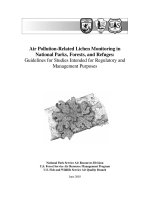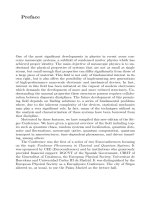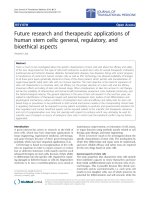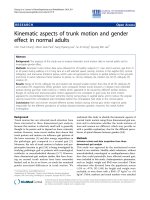Lesson Regulatory and spectrum aspects of 5G and IoT/M2M
Bạn đang xem bản rút gọn của tài liệu. Xem và tải ngay bản đầy đủ của tài liệu tại đây (903.14 KB, 40 trang )
Regulatory and
Spectrum Aspects
of 5G and IoT/M2M
Syed Tausif Abbas
Telecom Regulatory Authority of
India
IoT/M2M
1
Unique Characteristics of Indian
Telecom Industry
Enormous Size
Internet Penetration
Approximately 1.32 billion people in India.
§
§
Country divided in to 22 licence service
areas.
§
§
Total 1,191.40 Million connections.
§
Teledensity around 91.20.
Wireless Penetration
§
Wireless subscribers: 1,169.29 Million
§
Total Internet
Subscribers: 560
Million
Urban Internet
Subscribers per
100 population:
88.26
Rural Internet
Subscribers per
100 population:
21.76
Very competitive
Pricing
§
§
Urban Teledensity: 156.23
§
Rural Teledensity: 58.49
Data Usage of Mobile Users
§
Data Usage per subscriber per month
– GSM (2G+3G+4G LTE+CDMA): 8.32
GB
Telecom Financial Data
§
§
Very Competitive Market.
Tariffs are amongst
lowest in the world.
§
Gross Revenue during the quarter: Rs 57,827 Crore
§
ARPU: Rs 72.50
Source: TRAI’s performance indicator report ()
the
3
•
•
Machine to
Machine
(M2M)
Communicatio
ns
-Definition
•
•
Machine to Machine (M2M) refers to
technologies that allow both wireless
and wired systems to communicate with
other devices of the same ability.
M2M uses a device (such as a sensor or
meter) to capture an event, which is
relayed through a network (wireless,
wired or hybrid) to an application, that
translates the captured event into
meaningful information.
Machines can be connected through
host of media depending upon the
requirements e.g. wired, wireless (Wi-FI,
Bluetooth, 2G/3G/4G, PLC, Satellite etc.)
M2M is a subset of Internet of Things
(IoT). IoT comprises M2M and H2M
(Human to Machine) communication.
Machine to Machine
(M2M)
Communications
Trends
Ø
Ø
Ø
Global M2M connections have increased
with 37.6% CAGR annually for the last
five years.
By 2020 it is expected that the number of
connected M2M devices could be
anywhere from 20 billion to 100 billion.
In India, the Government’s vision of
setting up 100 smart cities, Intelligent
transport system, Digital India program
etc is expected to ignite proliferation of
M2M communication market in India
4
•According
to the Body of European
Regulators for Electronic Communications
(BEREC)’s report, current M2M services
broadly share some of the following
characteristics:
Characteristic
s of IoT/M2M
Services
•
Fully automatic communication of data
from remote devices (or with limited
human intervention).
•
Relatively simple devices that can either
be static (e.g. smart meters) or mobile
(e.g. M2M devices integrated in connected
cars).
•
Low volume traffic, often with sporadic or
irregular patterns. However, IoT/M2M
applications have already emerged and/or
might emerge in the future that transmits
data in greater volumes, especially if
demand for video-based services
increases (e.g. automatic analysis of
surveillance video streams, alarm
systems).
5
6
•
•
Characteristic
s of IoT/M2M
Services
•
•
IoT/M2M services require connectivity
though connectivity accounts for a
relatively low proportion of the overall
revenue opportunity in the M2M value
chain.
Many M2M services are provided via
devices designed and produced for
the world market and for usage based
on global mobility.
Many M2M devices are designed to
have a lifetime of many years and may
be installed within equipment or
infrastructure that itself has a long
lifetime. Therefore, the cost of
replacement may be relatively high.
In most cases, the business model is
B2B, even if devices may be aimed at
consumers (B2B2C). The business
model is usually not B2C.
IoT/M2M Layers
7
8
There are different ways in which IoT/M2M
services could be implemented:
Ø Different connectivity technologies may be
Implementation of
IoT/M2M
used and, in the case of wireless services,
different spectrum bands may be used.
Ø M2M services may use different protocols
to deliver their data. They may be based on
the IP protocol but could also use SMS,
USSD and/or automatic calls.
Ø An M2M device is addressed via an
identifier (e.g. number(s), IPaddress).
However, not all M2M devices need global
identifiers (e.g. those that are not
connected to public networks).
9
World’s eight leading Standards Development Organizations
(SDOs) have formed a partnership to develop specifications to
ensure the global functionality of M2M, allowing a range of
industries to effectively utilize the M2M technology.
oneM2M is the partnership of the following major ICT SDOs:
M2M
Standards
Ø
Association of Radio Industries and Businesses (ARIB)
Ø
Telecommunication Technology Committee (TTC) of
Japan
Ø
Alliance for Telecommunications Industry Solutions
(ATIS)
Ø
Telecommunications Industry Association (TIA) of the
USA
Ø
China Communications Standards Association (CCSA)
Ø
European Telecommunications Standards Institute
(ETSI)
Ø
Telecommunications Technology Association (TTA) of
Korea
Ø
Telecom Standards Development Society – India
(TSDSI)
IoT/M2M Applications
INDUSTRY/
VERTICAL
M2M APPLICATIONS
Automotive /
Vehicle tracking, e-call, V2V and V2I applications, traffic control, Navigation,
Infotainment, Fleet management, asset tracking, manufacturing and logistics
Transportation
Utilities / Energy
Smart metering, smart grid, Electric line monitoring, gas / oil / water pipeline
monitoring.
Health care
Remote monitoring of patient after surgery (e-health), remote diagnostics,
medication reminders, Tele-medicine, wearable health devices
Safety & Surveillance
Women Safety Bands, Commercial and home security
Surveillance applications, Fire alarm, Police / medical alert
Financial /Retail
Point of sale (POS), ATM, Kiosk, Vending machines, digital signage and
handheld terminals.
Public Safety
Highway, bridge, traffic management, homeland security, police, fire and
emergency services.
Smart City
Intelligent transport System, Waste management, Street Light control system,
Water distribution, Smart Parking
Agriculture
Remotely controlled irrigation pump, Remote Monitoring of Soil Data
10
monitoring,
IoT
Projections
•
•
•
According to Ericsson mobility report
2018, there are now over 17.5 Billion
connected devices in the world. This
figure is estimated to rise to 31.4
Billion by 2023.
Based on its research and analysis,
Telecom Engineering Centre (TEC)
of DoT, India has projected approx.
8.6 billion M2M/IoT devices in India
by 2020 .
As per GSMA, the proliferation of
connected devices will create a
USD 4.5 trillion market for global
business by 2020.
11
12
•
IoT Benefits
IoT has potential to bring
substantial social and economic
benefits
to
governments,
citizens,
end-users
and
businesses through increase in
productivity
and
competitiveness, improvements
in service delivery, optimal use
of scarce resources as well as
creation of new jobs thus
changing life of billions by using
trillions of devices.
IoT in Smart Cities
•
•
The Internet of Things (IoT) offers
new opportunities for cities to use
data to manage traffic, cut pollution,
make better use of infrastructure and
keep citizens safe.
IoT will produce data that can enable
optimized
productivity
across
industries, create truly smart cities
with smart grids, smart transport
systems and smart homes, bring in
efficiency
in
delivering
health
services, improve agricultural yields,
offer
personalized
customer
experience and enhance public
safety.
13
IoT in
HEALTHCA
RE
14
Importance of
IoT in
HEALTHCARE
•
•
•
•
•
•
•
•
Reduce healthcare costs
Remote diagnosis
Accelerate early disease
detection
Remote post surgical care
Monitor equipment
performance
Reducing the risk of human
errors
Monitor the consumption of
medicines
Improve diagnoses by bringing
together data from disparate
devices
•
•
IoT in
Agriculture
•
16
Farmers have begun employing
high tech farming techniques
and technologies in order to
improve the efficiency of their
day-to-day work.
Sensors placed in fields allow
farmers to obtain detailed maps
of both the topography and
resources in the area, as well
as variables such as acidity,
humidity and temperature of the
soil.
Farmers can access climate
forecasts to predict weather
patterns in the coming days and
weeks.
Importance of
IoT in Agriculture
•
•
•
•
•
•
Sensors to monitor insects and pests and
schedule release of pesticides
Sensors installed on farm equipment to
assist farmers to manage fleet of tractors
Carbon nanotube sensors to monitor level of
nutrients in crops, assisting farmers to
assess the maturity of produce
Connected equipment with GPS, monitoring
and electronic controls to help farmers
Remote sensors to help farmers monitor
vitals such as humidity, air, temperature,
soil, etc.
Geo-fencing of livestock, along with
irrigation scheduling and pump control
IoT in EDUCATION
18
Importance of
IoT in
EDUCATION
•
•
•
•
•
Enhance access to information
Make the teaching process
more efficient for professors
Improve the safety of campus
Improving the reach of
information through e-learning
Improve remote classroom
experience
IoT in
Financial
Services
•
The increased use of devices by
customers has led to increase in
IoT data. Banks are converting
the IoT data into valuable
information and thus, are
increasing their market share
and providing better services to
their customers.
20
Importance of
IoT in Financial
Services
•
•
•
•
•
•
Effortless no touch cashless payment
using RFID scanner.
Use sensors and analytics to gather
more information about customers and
offer more personalized services.
Banks can have a more vivid picture of
the consumer, understanding how they
move and where they spend money
which will allow banks to make more
accurate lending decisions.
Insurer can assess real usage patterns
of the insured device and can set rules
to remotely block behavior excluded by
the policy.
Can analyze the usage of ATM in
specific areas and increase/decrease
the installation of ATMs as well as plan
replenishment of cash based on usage
volumes.
Spectrum bands suitable for
IoT/M2M communications
22
23
Spectrum for
IoT/M2M
communications
Ø
M2M is based on the use of both the licensed
and the unlicensed spectrum.
Ø
Spectrum between 400 MHz band to 800
MHz bands are preferred for M2M/IoT
worldwide.
Ø
Sub 1GHz bands can be optimally used for
M2M communication due to:
ü Long range
ü Low interference
ü Low power consumption
ü Deep penetration
ü Low Total Cost of Ownership
(TCO)
Ø
In future, 5G is expected to accommodate a
wide range of IoT.
Licensed
Spectrum
Ø
In licensed approach, M2M can be deployed in any
harmonised mobile networks band, including 700MHz,
800MHz and 900MHz.
Ø
In 700 MHz band ECC Decision considers M2M as a
national option in the 733736MHz and 788791MHz
ranges (2x3 MHz).
Ø
700 MHz band is a sought after band for LTE
deployment around the world due to its efficiency and
propagation characteristics.
Ø
In one of its recommendations TRAI has recommended
the adoption of 3GPP Band28 of APT700 band plan for
700 MHz (698806 MHz) spectrum band with FDD based
2x45 MHz frequency arrangement with 10 MHz center
gap.
Ø
For efficient utilization of the center gap of 10 MHz (748
758 MHz), technical feasibility of utilizing a portion of
center gap for M2M (in TDD) can be explored while
keeping interference issues in mind
24
Unlicensed spectrum
Ø
ISM Band (2.4 / 5.8 GHz) is being used worldwide for M2M communication, however there is a
need for identification of additional bands due to scale of deployment of M2M/IoT devices.
Ø
In India too, two bands 2.4 GHz (2.4002.4835 GHz) and 5.8 GHz (5.8255.875GHz) have been
defined as Licenseexempt bands for indoor and outdoor applications.
Ø
In addition, 5.155.25 GHz and 5.7255.825 GHz are also available in India for indoor uses in
unlicensed bands.
Ø
Specifications of delicensed bands in Sub GHz band in India are given below:
S.N
Frequency
o.
Band
1
433-434 MHz
2
865-867 MHz
Use of this
Power Requirements
frequency
Maximum Effective Radiated Power: 10mW
band
Indoor
Maximum Channel Bandwidth: 10KHz
Maximum Transmitted power: 1W
applications.
Any low power
Maximum Effective Radiated Power: 4W
device or
Maximum Channel Bandwidth: 200KHz
25 equipment









